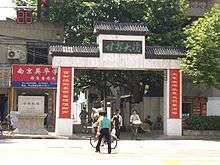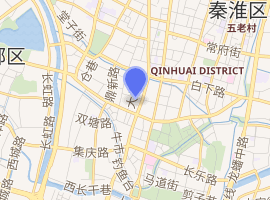Former Residence of Gan Xi
The Former Residence of Gan Xi, known as the Grand Courtyard of the Gan Clan, is located on Zhongshan South Road, Nanjing, Jiangsu Province, China. It lies next to Nan Bu Ting (南捕厅), the South station of the former Nanjing Police Station.[1] It was built in the reign of the Jiaqing Emperor (1796–1820), the Qing Dynasty, and its first owner was Gan Xi’s father, Gan Fu. Originally known as "Fraternity Hall" (友恭堂),[2] it now serves as the Nanjing Folk Museum.
| Former Residence of Gan Xi | |
|---|---|
甘熙故居 | |
 Entrance | |

| |
| General information | |
| Address | No. 15, 17 & 19, Zhongshan South Road |
| Town or city | Nanjing, Jiangsu Province |
| Country | China |
There is a well-known claim that the Forbidden City, the largest imperial palace complex, contains 9,999 and a half rooms, and that the largest mandarin estate, namely the Mansion of Confucius’ Descendants in Qufu, supposedly comprised 999 and a half rooms. As a large residence belonging to commoners, the Gan Family Mansion was often said by analogy to contain 99 and a half rooms, though in fact there are over three hundred.[3]
As the Nanjing Folk Museum, it displays an exhibition of handicrafts, including Yixing clay teapot, Chinese paper cutting, miniature engravings, Chinese opera make-up patterns (脸谱), old clocks as well as local snacks. It is worth noting that some parts of the residence are still privately owned or occupied by certain companies.
Transportation
The building is accessible within walking distance north of Sanshanjie Station of Nanjing Metro.
References
| Wikimedia Commons has media related to Former Residence of Gan Xi. |
- See also The History and Stories of Gan Xi's Residence (甘熙宅第史话). 南京出版社. 2008. p. 13. ISBN 978-7-80718-340-2.
- Bei, Chang (2009). The Art of Decorative Carving of Jiangnan architecture (Nanjing Volume) (江南建筑雕饰艺术 南京卷). 东南大学出版社. ISBN 978-7-5641-1662-0.
- See also the origin of the "99 and a half rooms" Fei, Xiao (2007). Anecdotes of Jiangsu. 旅游教育出版社. p. 242.
- "Nanjing Folk Museum (南京民俗博物馆)".
- The Former Residence of Gan Xi (甘熙故居) Hao, Ye (2006). The Culture and History of Jinling (金陵文脉). 南京出版社. ISBN 7-80718-215-6.